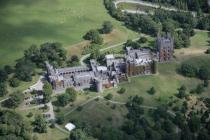Penrhyn - Slate and Wealth
Items in this story:
Penrhyn slate quarry
In the 19th century Penrhyn Quarry, along with Dinorwic Quarry, dominated the Welsh slate industry .
Penrhyn has the largest slate workings in the world and has remained in continuous production since long before the capitalisation of the workings by the first Lord Penrhyn in the late 18th century.
The quarry at that time was worked partly as a stepped gallery and partly as a pit, but from about 1850 it began to employ water-balance shafts to raise loaded wagons and installed 'blondin' ropeways in the upper quarry.
Production of roofing slates remained entirely unmechanised until the introduction of electricity in 1912, when a range of dressing mills on the main quarry level (the 'Red Lion level') were built. The workers at these mills were then the largest occupational group at the quarry, employed in sawing, splitting and dressing.
Penrhyn holds a significant place in the history of the British Labour Movement - it was site of two prolonged strikes by workers demanding better pay and safer conditions. The first strike lasted for eleven months in 1896, and the second, which began in November 1900, was to become the longest dispute in British history: the quarrymen were locked out for three years. The community was divided and thousands left the area, never to return.
In the mid-1960s the site was bought by McAlpine which led to extensive modernisation, and the quarry continues to produced and process slate to this day.
The italianate quarry office was built around 1860 during a period of expansion.
Industrial housing at Cefnan
The slate quarries of north-west Wales were often established in remote areas. Housing for the workers therefore had to be designed and built as the quarry was developed. The industrial housing at Cefnan was built in the 1870's on open land by workers at the Penrhyn Slate Quarry to designs set out by the quarry management. It consists of regular rows of cottages and gardens. Those fortunate enough to have gardens, would look after them meticulously, growing vegetables and having a pigsty at the far end from the house.
Other quarry workers were housed in two-roomed barracks where they spent the week, travelling as far as Llangefni in Anglesey to go home at the weekends.
Slate export
Penrhyn quarry had its own port, ships and waggonway system; Porth Penrhyn is a harbour complex to the north-east of Bangor. It was established in 1790 to serve the Penrhyn estate, at first as a single quay along the Afon Cegin. It was extended in 1803 and again c.1830, and in 1855 a wet dock (one without gates) was added.
In 1798 a horse-drawn waggonway was opened to carry flint to the port for transit to the Staffordshire pottery industry. In 1801 the waggonway was extended to the Penrhyn slate quarries near Bethesda, and the port developed as a major exporter of slates. A slate mill at the port (making writing slates) was built in 1801. A connecting line to the Chester & Holyhead (L&NW) Railway was completed in 1852, and in 1879 a new route for the Penrhyn Railway, avoiding the three gravity-worked inclines and allowing the use of steam locomotives, was completed. Slates continued to be exported from the port until 1962, when the Penrhyn Railway closed.
Penrhyn Castle
Landed estates enriched by mineral incomes resulted in great houses being created in Wales according to the latest tastes. Penrhyn Castle, one of the most enormous houses in Britain, is an extensive Neo-Norman fantasy castle by Thomas Hopper, largely built from the early 1820s to 1837 for the Pennant family as an expression of their vast wealth obtained from slate and from their Jamaican estates.
Slate was used extensively in the construction of the building and a four ton slate four-poster bed was built for a visit by Queen Victoria in 1859, her visit an indication of the importance and wealth of Penrhyn. In 1899, the profits from the slate quarry were twice the value of the estate's land rents; the Pennants at the time were the third biggest landowners in Wales.
In 1951 Penrhyn Castle and a large part of the estate were transferred to the treasury in lieu of death duties. The quarry and estate interests were separated and a limited company was formed to run the quarry.
The castle is now owned by the National Trust.
Story contributed by: RCAHMW



